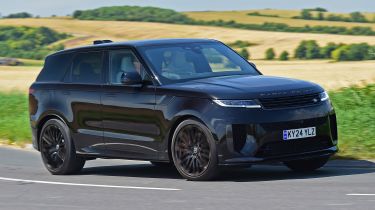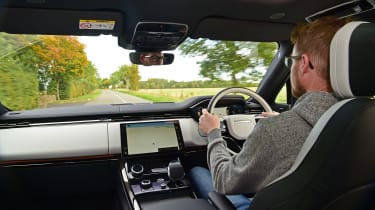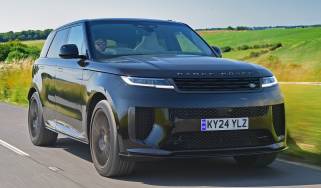Range Rover Sport review – Engines, drive & performance
"The Sport offers a superb blend of unflappable refinement and driver engagement"
Despite what their names suggest, large Sports Utility Vehicles hardly offer the best in driver engagement. There are, however, a handful of models such as the Porsche Cayenne that are able to offer a sporty and fun driving experience, despite weighing over two tonnes.
So, does the Range Rover Sport live up to its exciting name? Yes and no. Make no mistake, this is no Porsche Cayenne, nor does it handle as sharply as, say, a BMW X5 M Competition. However, thanks to a lighter, stiffer chassis, the new Sport handles much better than the model it replaces and is surprisingly fun to drive for such a large car.
The Range Rover Sport’s air suspension helps keep body lean in check through tight corners, while the steering is direct and perfectly weighted. All models come with permanent four-wheel-drive as standard, meaning that there should be plenty of grip, even in the slipperiest of conditions.
The only real issue we have with the new Range Rover Sport’s driving experience is its gearbox; when cruising around town, it gently slushes through the gears to the point you can barely notice it is doing so at all. However, when you do eventually put your foot down, it can be relatively slow to respond and doesn’t quite have the urgency of the PDK gearbox fitted to the equivalent Cayenne.
More reviews
Car trim reviews
In-depth reviews
- Range Rover Sport review – comfortable and good to drive
- Range Rover Sport PHEV review
- Range Rover Sport PHEV SUV (2013-2022) review
- Range Rover Sport SUV review (2013-2022)
Road tests
Used car reviews
The Range Rover Sport SV feels like a different beast altogether. It costs nearly £100,000 more than the entry-level Range Rover Sport and brings performance of a completely different league. The 626bhp V8 is bombastic, but it’s the handling that really shines. A clever hydraulic suspension system – not dissimilar to what you’ll find under McLaren’s supercars – practically eliminates body roll, giving it a sense of poise that defies its size.
Diesel engines
Despite diesel falling out of favour with UK buyers, Land Rover offers three models for those who prefer using the black pump at the filling station. The entry-level D250 is the cheapest engine in the Range Rover Sport lineup and comprises a 3.0-litre six cylinder engine with 48-volt mild-hybrid assistance. Altogether, this produces 247bhp and propels the two-tonne SUV from 0-60mph in 7.3 seconds
Stepping up above the entry-level S trim brings the D300 engine as standard. This is the same basic engine as the D250, but with a power bump to 296bhp, cutting the 0-60mph time to 6.1 seconds. Autobiography models are available with the D350 engine, which gets 345bhp and a 0-60mph time of 5.5 seconds.
Regardless of which one you choose, all three diesels seem like a perfect fit for such a large car due to the huge amount of torque – even the base D250 produces a hefty 600Nm – that is available at lower speeds. While diesels are renowned for being rattly and unsophisticated, the Sport’s units emit a satisfying rumble and are never too obtrusive.
Petrol engines
The Range Rover Sport is now offered with two petrol engines, the previous P400 having been discontinued. Now the entry-level petrol is the P530, which gets mild-hybrid technology for a power figure of 528bhp, which means it goes from 0-62mph in a sprightly 4.3 seconds and onto a top speed of 155mph.
That’s not even the quickest version though; that honour goes to the Range Rover Sport SV which produces a whopping 626bhp. This isn’t a Range Rover for the faint of heart and at over £170,000, it sits head and shoulders above the rest of the lineup in terms of price and performance. Under the bonnet lies a BMW-sourced 4.4-litre twin-turbocharged V8 engine, rated for 626bhp. The 0-60mph sprint is over in just 3.7 seconds and it’ll plough on until it hits 180mph. Even a Porsche Cayenne Turbo E-Hybrid will struggle to keep up with that.
Unlike the old Range Rover Sport SV, which drove a bit like someone had strapped a rocket to the base model, the new one feels far more cohesive. It’s a true driver’s car, cornering with a precision that’s scarcely believable for a car weighing 2,600kg. Of course, it still feels tall and wide on our narrow British roads, but we think it’s one of the best performance SUVs on sale today.
If there is an area of weakness, it’s the sound. The old model’s supercharged V8 was thunderous, but the new engine is a bit muted in comparison. Still, in a world of electric SUVs, you’ll certainly still hear the SV coming.
Hybrid engines
This third generation of Range Rover Sport is not the first time the SUV is available with a plug-in hybrid powertrain; however, buyers now have the choice of two different power outputs. Badged P460e and P550e, both plug-in hybrids make use of a 3.0-litre six cylinder petrol engine, alongside a 38.2kWh battery and a 141bhp electric motor.
The entry-level P460e altogether produces an impressive 454bhp and can get from 0-60mph in 5.3 seconds. In reality, it feels even faster thanks to the instant torque from the electric motor.
The P550e uses a more powerful variant of the six-cylinder engine in order to produce 542bhp – more than the old P530 V8 model. The P550e is the fastest plug-in hybrid Range Rover Sport model to reach 62mph, taking just 4.7 seconds.
Unfortunately, as is the case with most plug-in hybrids, the PHEVs aren’t the best choice for keen drivers. Both variants weigh in at over 2,700kg – around 300kg more than the diesels. Consequently, plug-in Range Rover Sports won’t feel quite as nimble as their mild-hybrid and V8 siblings on a twisty road.














